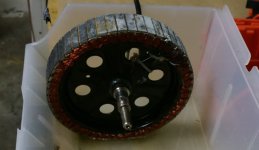My question is why wouldn't the frequency of the pwm create something similar to torque ripple. torque ripple seems to explain the level of torque based on the amount of poles and the distance between them I'm talking of with much smaller time periods the frequency of the pwm. At half duty cycle you can have a high frequent or low just as long as measured within the time period it in on half the time. According to what I posted the inductance time constant reveals the time it will take the coil to build its magnetic field. If it were to take less time to build the field, especially during low duty cycle when there are possibly many amps fed to the motor in pulses, the magnetic field would build and collapse in fractions of a second and the motor would therefore produce pulses of torque. But the magnetic field is produced slower than the frequency and the rapid pulses are smoothed out. No torque pulses and also according to the link the higher the frequency the better in this regard. That's what I got from this, this is how I understand it, what's missing?
I did the math to figure how long it takes with my motor for the field to build and collapse, don't have the numbers now but it's like .00006 seconds or something per period, and the frequency I believe is .00002 or something , so no torque pulses as the field takes 5 periods to get 99.5% complete


